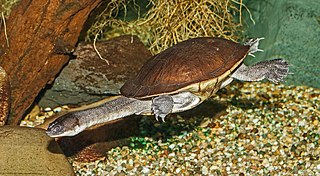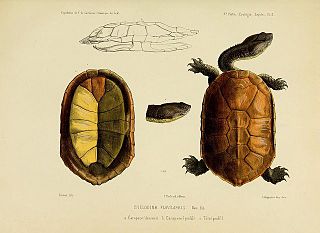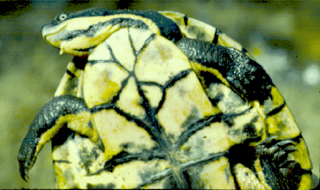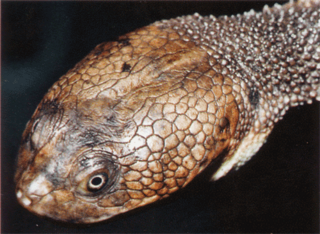
Chelidae is one of three living families of the turtle suborder Pleurodira, and are commonly called Austro-South American side-neck turtles. The family is distributed in Australia, New Guinea, parts of Indonesia, and throughout most of South America. It is a large family of turtles with a significant fossil history dating back to the Cretaceous. The family is entirely Gondwanan in origin, with no members found outside Gondwana, either in the present day or as a fossil.

The eastern long-necked turtle is an east Australian species of snake-necked turtle that inhabits a wide variety of water bodies and is an opportunistic feeder. It is a side-necked turtle (Pleurodira), meaning that it bends its head sideways into its shell rather than pulling it directly back.

Chelodina, collectively known as snake-necked turtles, is a large and diverse genus of long-necked chelid turtles with a complicated nomenclatural history. Although in the past, Macrochelodina and Macrodiremys have been considered separate genera and prior to that all the same, they are now considered subgenera of the Chelodina, further Macrochelodina and Macrodiremys are now known to apply to the same species, hence Chelydera is used for the northern snake-necked turtles.

The Pleurodira are one of the two living suborders of turtles, the other being the Cryptodira. The division between these two suborders represents a very deep evolutionary divide between two very different types of turtles. The physical differences between them, although anatomical and largely internal, are nonetheless significant, and the zoogeographic implications of them are substantial. The Pleurodira are known more commonly as the side-necked turtles and the name Pleurodira quite literally translates to side neck, whereas the Cryptodira are known as hidden-necked turtles. The Pleurodira turtles are currently restricted to freshwater habitats in the Southern Hemisphere, largely to Australia, South America, and Africa. Within the Pleurodira, three living families are represented: Chelidae, also known as the Austro-South American side-necked turtles, the Pelomedusidae, also known as the African mud terrapins, and the Podocnemididae, also known as the American side-neck river turtles. However, they were cosmopolitan clade during the Cretaceous and most of the Cenozoic, and even occurred in marine environments around the world.

The Roti Island snake-necked turtle, also commonly known as McCord's snakeneck turtle, is a critically endangered turtle species. It is named after Rote Island in Indonesia where it was first discovered. Some individuals were later discovered in East Timor, and are considered a distinct subspecies.

The Argentine snake-necked turtle, also known commonly as the South American snake-necked turtle is a species of turtle in the family Chelidae. The species is known for the long neck to which its common names refer. Despite appearances, the Argentine snake-necked turtle is probably more closely related to the mata mata than to the Australian snake-necked turtles in the genus Chelodina. H. tectifera is found in northern Argentina, Uruguay, Paraguay, and southern Brazil. Not much is known about it, as it has not been extensively researched. It is a popular pet in the exotic pet trade.

Acanthochelys is a genus of turtles, the spiny swamp turtles, in the family Chelidae, subfamily Chelinae, found in South America. Until recently, the species of this genus were considered to be members of the genus Platemys, but were moved to the resurrected genus originally described by Gray (1873) based on the type species by monotypy Acanthochelys spixii.

The oblong turtle, also known commonly as the narrow-breasted snake-necked turtle and the southwestern snake-necked turtle, is a species of turtle in the family Chelidae. The species is endemic to the southwestern part of Western Australia.
Pritchard's snake-necked turtle is a species of turtles in the family Chelidae. The species is endemic to a restricted area of Central Province, Papua New Guinea.
Reimann's snake-necked turtle is a species of turtle in the family Chelidae. The species is endemic to Oceania and Southeast Asia.

The northern snake-necked turtle or northern long-necked turtle is a species of turtle in the family Chelidae or Austro-South American Side-necked Turtles. It is native to northern Australia and southern New Guinea.

The red-bellied short-necked turtle, also known commonly as the pink-bellied side-necked turtle and the Jardine River turtle, is a species of turtle in the family Chelidae. The species is native to Australia and New Guinea. There are two recognized subspecies.

The Brazilian snake-necked turtle, locally known as cágado da serra, and also commonly known as Maximilian's snake-necked turtle, is a species of turtle in the family Chelidae. The species is endemic to southeastern Brazil. It is one of the smallest Brazilian freshwater turtles reaching a maximum straight carapace length of 20 cm (7.9 in). The species prefers streams with sandy and rocky bottoms and clear water in forests above 600 m (2,000 ft) elevation.

Sometimes called the bearded toadheads but better known by their scientific name of Phrynops this genus of turtles has often been a bit of a dumping ground for the short-necked South American turtles of the family Chelidae.

The Myuchelys is a genus of turtles, the Australian saw-shelled turtles, in the family Chelidae and subfamily Chelodininae. They inhabit the headwaters and tributaries of rivers within their range and this led to the name Myuchelys, which is formed from the Aboriginal word myuna meaning clear water and the Greek chelys meaning turtle. They have a short neck and the intergular scute completely separates the gular scutes. They have no alveolar ridge separating them from the snapping turtles of the genus Elseya.

Chelodina canni, also known commonly as Cann's snake-necked turtle, is a species of turtle in the family Chelidae. The species is endemic to Australia, where it is found in the northern and northeastern parts of the continent. It has a narrow zone of hybridization with its related species the eastern snake-necked turtle, C. longicollis. For many years C. canni was assumed to be the same species as C. novaeguineae from New Guinea. However, in 2002 it was shown that these two species differ both morphologically and genetically, and therefore C. canni was separated and described as a unique species.

Chelodina (Chelydera) burrungandjii, the sandstone snake-necked turtle or Arnhem Land long-necked turtle, is a medium-sized turtle reaching carapace lengths of 316 mm. The species is found in the sandstone plateaus and escarpments and the plunge pools of Arnhem Land of the Northern Territory. The species had been long recognised as valid. However, it had been difficult to research due to the remoteness of its habitat. Efforts to breed this species in captivity had been largely unsuccessful, until National Aquarium Herpetologist Matthew Benedict lead a successful breeding project in 2021. The species occurs in proximity to Chelodina rugosa, to which it is closely related. For the most part the two species are parapatric in distribution. However, they do come together in limited locations such as plunge pools at the base of the escarpments. In these areas there is hybridization between the species.

Phrynops hilarii, also commonly known as Hilaire’s side-necked turtle and Hilaire's toadhead turtle, is a species of freshwater turtle in the family Chelidae. The species is endemic to South America.
Yaminuechelys is an extinct genus of chelid turtle from Argentina and the Dorotea Formation of Chile. The genus first appeared during the Late Cretaceous and became extinct during the Late Paleocene.
Chelodina gunaleni, also known commonly as Gunalen's long-necked turtle and Gunalen's snake-necked turtle, is a species of turtle in the family Chelidae. The species is endemic to the lowlands of west-central West Papua, Indonesia, south of the central ranges.
Molina, F. J., & Leynaud, G. C. (2017). Thermoconformity strategy in the freshwater turtle Hydromedusa tectifera (Testudines, Chelidae) in its southern distribution area. Journal of Thermal Biology, 69, 178–183. https://doi.org/10.1016/j.jtherbio.2017.07.008















